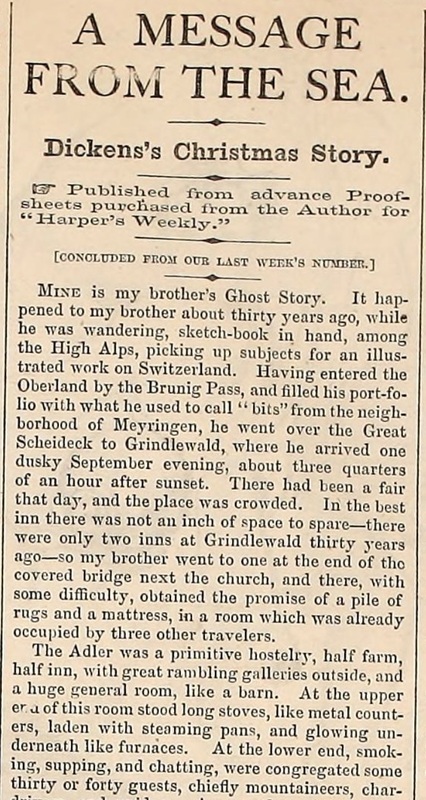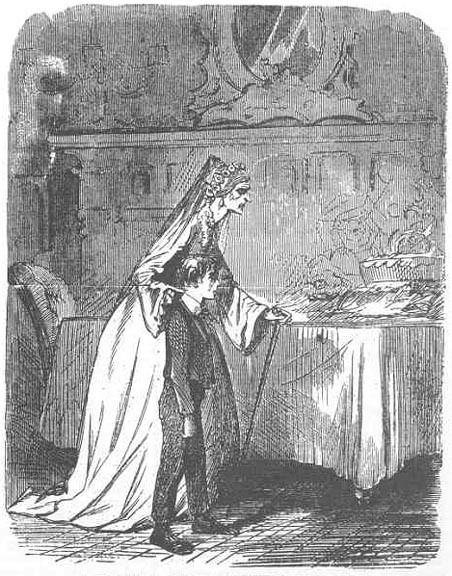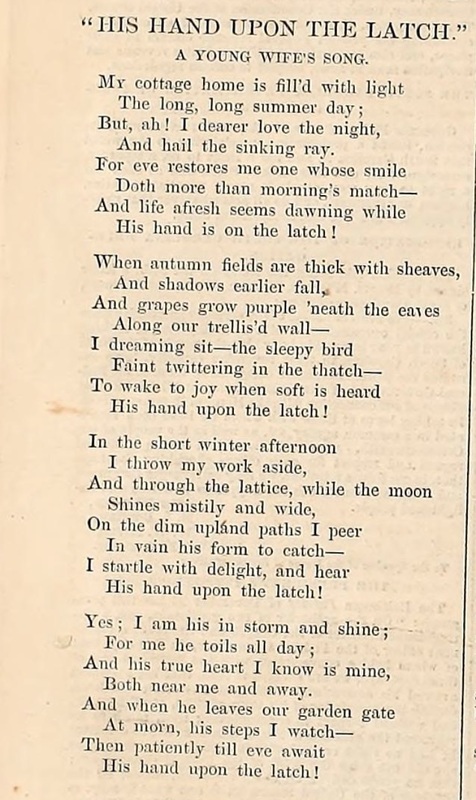Part 7
Charles Dickens’ Great Expectations includes a multitude of themes within each of its chapters—and chapter eleven is no exception as it develops the relationships between Pip and key female figures like Estella and Miss Havisham. His connection to Miss Havisham explores his notions regarding social status and wealth whereas his relationship with the domineering Estella supports a feminist narrative by dismantling the feminine ideal and subverting traditional gender roles. Since Pip is not the dominant figure in either of these relationships, deeming himself obliged to Miss Havisham for finances and Estella for romance, Dickens centralizes complex female characters and situates them in positions of power over men. In volume five of Harper’s Weekly, the eleventh chapter is enveloped by paratext that maintains a feminist narrative through its expansion of femininity beyond the idealized, association of wealth with women, and depiction of conventional gender relations only to undermine them. By reading chapter eleven in both the modernized copy of Charles Dickens’ Great Expectations along with its original publishing in Harper’s Weekly, the reversal of Victorian gender roles and the promotion of round, dominant female characters is significantly uncovered and established.

A Message From the Sea.
Placed immediately after the end of chapter eleven in Harper’s Weekly lies another short story by Charles Dickens titled “A Message from the Sea”. This story, similarly to Great Expectations, focuses on wealth and the means by which individuals will go to achieve it as one of the characters in “A Message from the Sea” steals a large sum of money, mirroring Pip’s desire for wealth in Great Expectations. Chapter eleven finds Pip at Satis House while Miss Havisham hosts guests who are equally as affluent as herself. He observes how the guests “somehow conveyed to [him] that they were all toadies and humbugs,” further noting how “each of them pretended not to know that the others were toadies and humbugs” (Dickens 115). Pip’s diction in “toadies and humbugs” asserts how Miss Havisham’s guests employ extreme flattery, acting as imposters as they use Miss Havisham for her wealth. Despite Pip’s recognition of the frivolousness and dreariness that stems from gaining wealth from superficiality, he continues to strive toward this status. Both Great Expectations and “A Message from the Sea” scrutinize the blatantly drastic ways in which individuals attempt to gain wealth—by stealing in the latter of the stories or by pure association in the prior. During this chapter, Pip is receiving premiums from Miss Havisham and associates her with his own potentially prosperous future. Pip’s correlation between Miss Havisham and wealth places Miss Havisham as a position of power, an unlikely role for a woman to play in this period as men were largely deemed the breadwinners. Miss Havisham being an extremely wealthy woman plays a large role while analyzing not only the theme of class in this novel, but also the theme of feminism. This feminist choice is additionally made in Dickens’ “A Message from the Sea” as once the stolen money is recovered, it is gifted to one of the character’s daughters. Interestingly, in both of Dickens’ tales of men striving to gain large sums of money, doing whatever it takes to achieve such, it is primarily the female characters who have or end up with it. Through this link in both of Dickens’ tales placed closely together in Harper’s Weekly, readers recognize how it is the women who are financially in positions of power above men: with Kitty, the daughter in “A Message from the Sea”, and Miss Havisham in Great Expectations, maintaining a feminist reading by reversing Victorian gendered financial hierarchies.

"It's a great cake. A bride-cake. Mine!"
As previously mentioned, Miss Havisham plays a crucial role in Dickens’ Great Expectations, not only in her involvement in Pip and Estella’s lives but also in her responsibility to the text as a whole. Miss Havisham is a prime example of Dickens’s ability to write round female characters, granting her female agency by allocating space in the text for her fallen woman story.Although this is not a beautifully romantic or inspirationally liberating tale, it is realistic and allows for feminine representation in literature to stray from the feminine ideal. This notion is largely explored in chapter eleven as more of Miss Havisham’s backstory is revealed, most strikingly through John McLenan’s illustration in Harper’s Weekly. The illustration is in the corner of the page, interrupting the chapter’s text. This showcases Miss Havisham’s looming presence in both Pip’s life and the text itself; her image overlooks readers, continuously demanding their attention as one continues to read. McLean’s illustration of Miss Havisham highlights this aforementioned power that she holds as the page is forced to make room for her occupancy and the chapter compelled to halt for the large illustration, having no choice but to pick up where it left off on the following page. Miss Havisham is by no means a strikingly feminist character, but her existence and the part she plays in chapter eleven and Great Expectations entirely, is feminist. Miss Havisham is not the picture-perfect, submissive, ideal Victorian woman and her illustration depicts this. Her back is hunched and her face is wrinkled as she points to her bride cake that is covered in spiders, revealing how being left at the altar has permanently aged and affects both herself and her environment. Miss Havisham speaks of this premature aging, referencing her cake by stating, “It and I have worn away together” (123). She is far from the perfect bride or the perfect woman that men would have wanted to read about in the period, and it is this perception that enforces her textual essentiality. Through Miss Havisham, Dickens reverses gender roles by portraying extremely dominant women who force the story to make room for their presence, just as her illustration does to the body of text.

Humors of the Day
Estella is another example of a dominant female Dickensian character in Great Expectations, contradicting traditional gendered relationship dynamics and depictions of femininity by exemplifying an antithesis to the literary feminine ideal in her own characterization and the power she holds over Pip in their relationship. In this joke placed closely to chapter eleven, a “young lady who gave herself many airs” (Unknown 3) is described in a mocking tone as one who “knew what [the young lady’s] powers of language were, expresses how “she’ll never forget the vulgar tongue!” (3) This joke is an example of the societal tendency to shame and degrade girls who give themselves airs, which in other words, implies girls who are snobby or think very highly of themselves. With this knowledge, these mockeries are placed and advertised in papers to discourage women from being ‘too’ overbearing, ‘too’ proud, or ‘too’ loud—promoting the Victorian feminine ideal. While the joke is placed in the humours of the day section, it is likely not a joke at all as these are the exact traits that men deemed undesirable and discouraged women from having; however, it is these traits that Estella maintains throughout Dickens’ Great Expectations. Specifically, in chapter eleven, Estella is arrogant as ever to Pip as she questions him, appearing as an attempt to determine if he’ll shun the nature of her attitude as society does. She initially asks, “Am I pretty?” (Dickens 116) and Pip replies, “Yes; I think you are very pretty” (116). She pushes further, “Am I insulting?” and Pip says no. Finally, Estella slaps Pip, her final test of his love for her, prodding, “Now?...What do you think of me now?” to which Pip refuses to tell her (116). In this scene, Estella mirrors the “vulgar tongue” (Unknown 3) of the girl in the joke, yet Pip does not mock or belittle Estella, as the patriarchal society would encourage, even despite the vulgarity of her words and actions. This demonstrates how ridiculing does not solve the issue at hand, and perhaps the airs that women like Estella and the girl in the joke, have are simply a reaction to these confining societal standards. Through this instance, it is clear that Estella has internalized how society views and treats young women like her as she tries to see if Pip will treat her similarly, desperate for someone to see past her outwardly callousness. It is evident that the young lady in the joke equals Estella in attitude yet lacks the agency that Dickens grants to Estella by allowing her character to develop past her pretentiousness, or in spite of it—a liberty that the girl in the joke is not bestowed as she textually remains nothing more than a mere mockery. As the joke is situated near chapter eleven, it establishes how domineering or, in other terms, powerful women were frowned upon and ridiculed as they strayed from the typical feminine ideal whilst demonstrating how Dickens refrains from limiting Estella to such. Maria Ioannou agrees with this notion stating, “In its treatment of Estella, Great Expectations can be read as a novel which endorses the woman’s perspective” by “endors[ing] a female ideal that is…powerful” (Ioannou 142); this promotion is significantly heightened by the joke to juxtapose two reactions to powerful young girls. Estella is portrayed as more than just a ‘humour of the day’ by growing beyond the ‘bossy girl’ stereotype through the revealing of how Estella’s upbringing has shaped her and her presentation, not as a villain, but as a round character who is capable of growth and love. Estella finds, in Pip, a man who appreciates her dominance rather than shaming it. This notion affirms how Dickens’ portrayal of women was more dimensional and progressive than those of others in his time as exemplified in the misogynistic joke. Therefore, this joke is situated next to chapter eleven to showcase the public scrutiny against powerful women, ultimately promoting Dickens’ characterization of Estella as she is granted the liberty of being loved instead of laughed at.

His Hand Upon the Latch
This young wife’s song occurs right before chapter eleven of Great Expectations, forming a juxtaposition in relationship dynamics between the two texts and thus, demonstrating Dickens’ development past traditional Victorian gender roles. The song depicts a woman waiting at home, longing for her husband to return from work which conforms to conventional gendered responsibilities. However, Pip and Estella reverse these norms by swapping the standardized duties for their gender with Estella being dominant in their relationship and Pip following her lead. This gender role reversal, as Ioannou argues, “reformulates conventional expectations of masculinity and femininity” as well as “revises conventional ideals of masculinity and femininity” (Ioannou 144). Estella will never be the patient wife that waits at home for her husband, longing for his attention and devotion, thereby “repudiat[ing] the angel wife ideal” that is highlighted in this song, by expanding womanly roles in relationships (144). Instead, Pip plays the wifely role of the wife who desires her partner’s attention as he constantly pursues Estella’s, embodied in his fight with Herbert Pocket. Estella kisses Pip after the fight, establishing the power she holds over Pip rather than vice versa while asserting her sexuality and power as her impulse is to reward him with a kiss—which is a physical form of love—demonstrating how she shows her love through physicality, subverting typical feminine ideals. Ioannou furthers this by pronouncing the novel’s feminism as “the love of the man must clearly involve an acceptance of and affirmation in the woman’s power” (149), as seen in Pip’s willingness to yield to Estella. Thus, the imagery of classical Victorian gender roles sits paradoxically close to chapter eleven to showcase differing forms of gender dynamics in relationships, and a growth past conventionality as Pip longs for Estella, placing the power in her hands.
In viewing the paratext surrounding chapter eleven in Harper’s Weekly, the novel’s feminist agenda is uncovered. These items affirm the importance of context while reading modernized novels by detailing how ‘difficult’ women were viewed and describing relationship norms and a woman’s financial role. By writing Estella and Miss Havisham antithetical to the feminine ideal—granting them power over men—and demonstrating gendered relationship dynamics that stray from conventionality, Dickens demonstrates an ability to grow outside the Victorian norms represented in the surrounding paratext.
Works Cited
Dickens, Charles. "A Message From the Sea". Harper's Weekly, vol. 5, 5 Jan. 1861, pp. 7-15. Internet Archive. https://archive.org/details/harpersweeklyv5bonn/page/6/mode/2up
Dickens, Charles, et. al. Great Expectations. Broadview Press, 1998. https://archive.org/details/harpersweeklyv5bonn/page/4/mode/2up?view=theater
Dickens, Charles. "Great Expectations: Chapter XI." Harper's Weekly, vol. 5, 5 Jan. 1861, pg. 5. Internet Archive.
Ioannou, Maria. “‘[S]imply Because I Found Her Irresistible’: Female Erotic Power and Feminism in ‘Great Expectations.’” Dickens Quarterly, vol. 29, no. 2, 2012, pp. 142–50.
Unknown. "His Hand Upon the Latch." Harper's Weekly, vol. 5, 5 Jan. 1861, pg. 5. https://archive.org/details/harpersweeklyv5bonn/page/4/mode/2up?view=theater
Unknown. "Humors of the Day." Harper's Weekly, vol. 5, 5 Jan. 1861, pg. 3. Internet Archive. https://archive.org/details/harpersweeklyv5bonn/page/2/mode/2up?view=theater